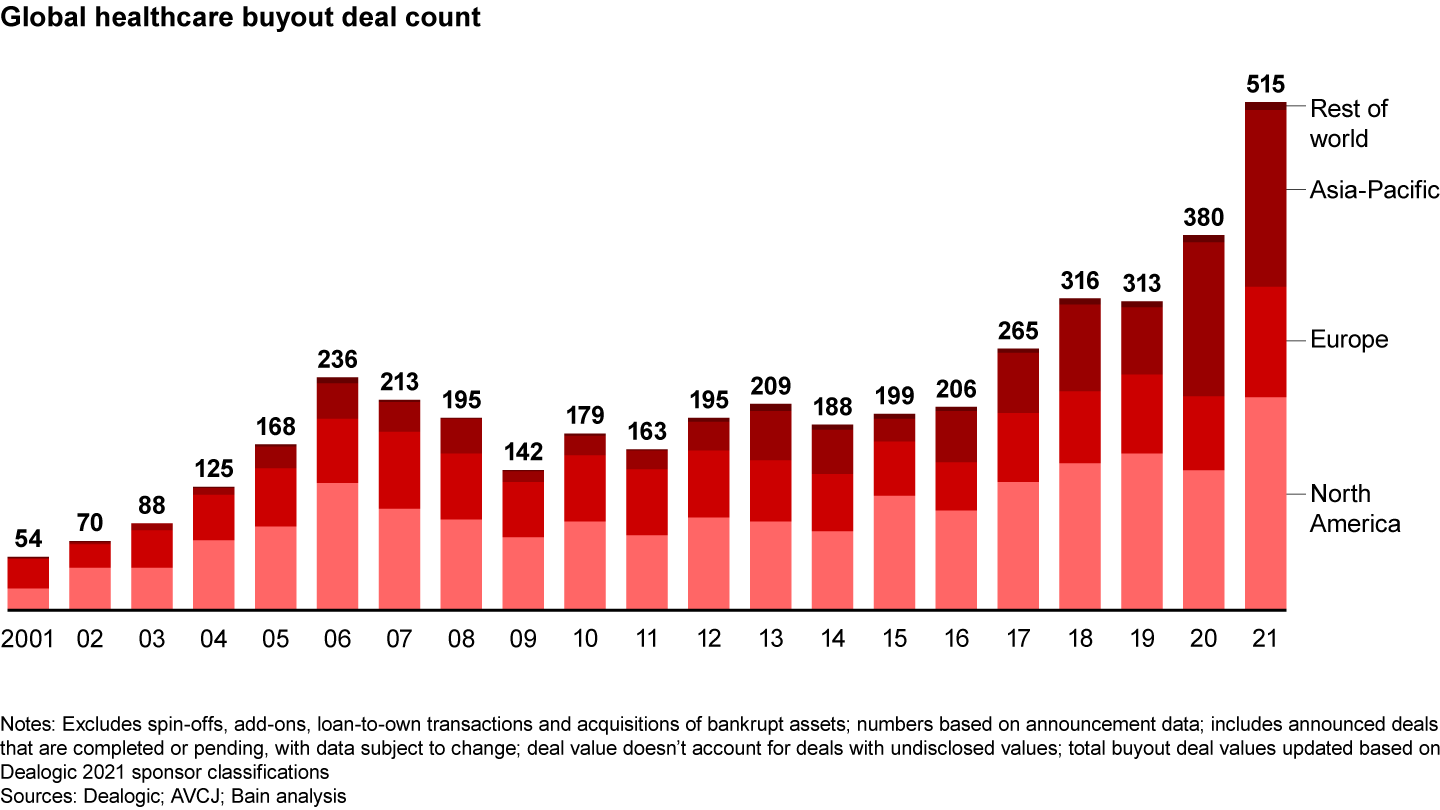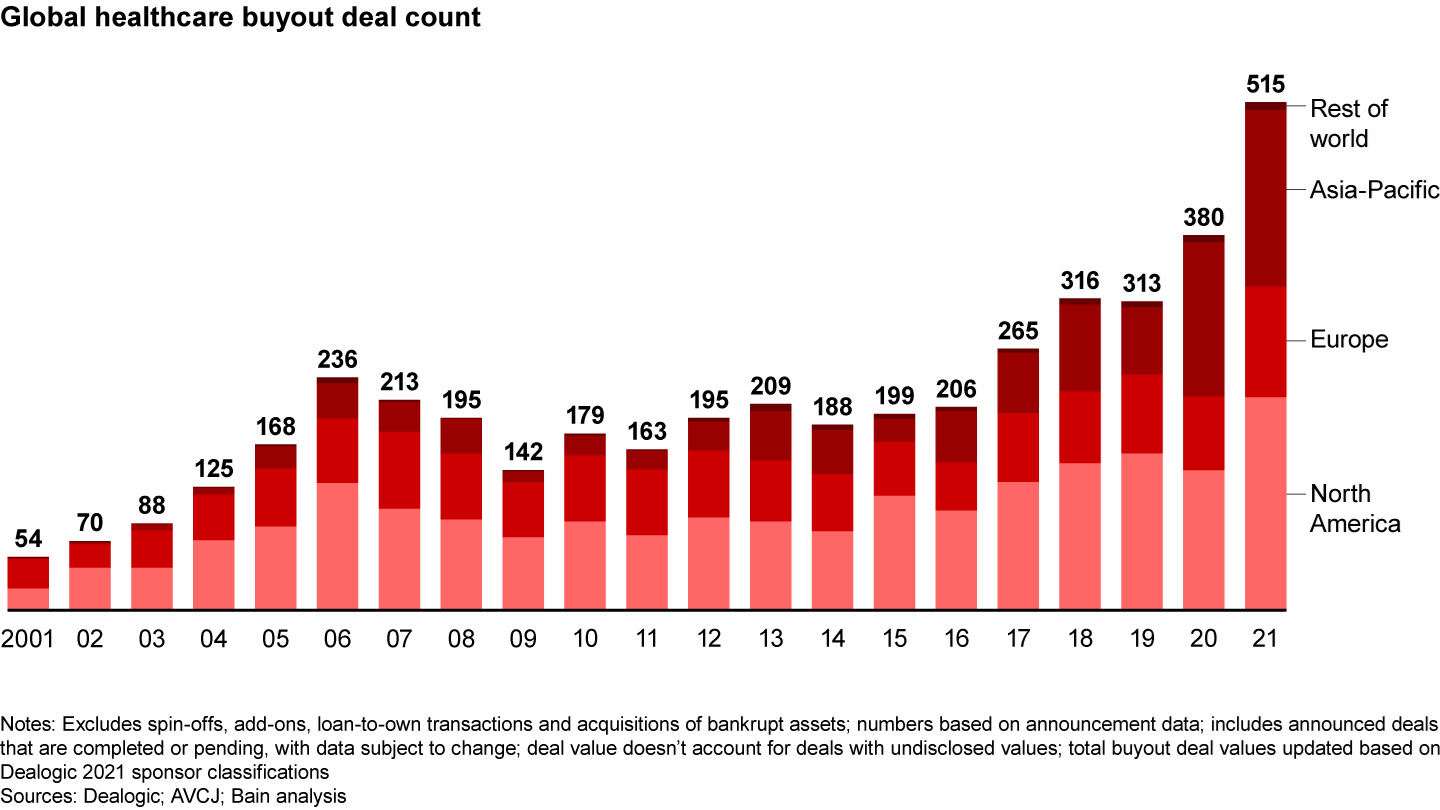Report

At a Glance
- Europe broke all records in 2021, with deal count growing by 49% and disclosed value rising 86%.
- Retail health segments such as veterinary care, dental, and fertility were investor favorites, with interest gradually shifting toward less consolidated retail segments.
- Many funds are allocating a greater share of their capital to healthcare, making for riskier investments in a sellers’ market.
- Pan-European companies will be relatively insulated from regulatory and reimbursement risk in any one country and attract outsize investor interest.
This article is part of Bain's 2022 Global Healthcare Private Equity and M&A Report
Large deals made a comeback in Europe during 2021, with the healthcare buyout market heating up to record highs. Deal count rose to 112 from 75 in 2020, and disclosed deal value surged to $26 billion from $14 billion the prior year (see Figure 1). Four deals over $2 billion accounted for 61% of disclosed value.
In line with global trends, European limited partners have been allocating a greater share of their funds to healthcare, attracted by the industry’s relatively high returns over time and resilience to economic cycles. In this sellers’ market, acquisitions became increasingly competitive, and investors increasingly front-loaded or curtailed direct diligence, taking on more risk.


Let’s review how each sector fared during the year.
Healthcare providers: retail health rebounds with megadeals in veterinary care
Provider deals accounted for the greatest share of activity in Europe, as the count rose to 42 from 28 in 2020. But providers accounted for only $5.8 billion in disclosed value, down from last year’s record $9.4 billion.
After a lockdown-induced slump in 2020, retail health returned as an investor favorite once patient volumes rebounded. Most assets have traded hands among private equity firms many times, confirming the opportunities for value creation through further consolidation as well as business optimization. Large deals occurred in veterinary care, a mature and consolidated segment in many European markets, as demand rose for pet care and associated services. Notably, Silverlake and Nestlé purchased part of EQT’s stake in Independent Vetcare, a large UK-based practice group that operates in 12 European countries, for $4.2 billion. Activity increased in dental and fertility, which are less consolidated segments in most European markets, as investors looked for opportunities in more fragmented retail health segments. Intermediate Capital Group acquired Godt Smil, a Danish chain of clinics. And CVC acquired a stake in FutureLife, a pan-European in vitro fertilization provider, alongside the company’s current investor, Hartenberg Holding.
Following the pandemic-accelerated shift of care out of hospitals as Covid-19 patient volumes surged and elective procedures were canceled, home health services made attractive targets. Many home care providers compete in only one major European market, given regulatory, reimbursement, and language differences that make cross-border scaling difficult. For example, Amira Partners bought PflegeButler Häusliche Pflege mit Stil, a German provider of home health services and assisted living facilities. And Palatine Private Equity acquired Routes Healthcare, a UK home health provider, from Key Capital Partners.
Biopharma and life sciences: megadeals for OTC manufacturers, commercialization services, and lab providers
Biopharma and life science tools and diagnostics accounted for 74% of disclosed deal value in Europe, rising to $19.3 billion from $4.1 billion in 2020. Six deals over $1 billion accounted for roughly 90% of the disclosed value. Likewise, biopharma and life sciences deals increased to 44 from 37 in 2020.
With its strong academic and scientific talent and infrastructure, Europe continues to produce many innovative therapeutic and life sciences companies. Investment during the year flowed along three themes: over the counter (OTC) and generic medicine manufacturers, contract development and manufacturing organizations (CDMOs), and clinical lab service providers.
OTC manufacturers attracted interest for their predictable revenues, follow-on acquisition opportunities, and potential for revenue growth through branding campaigns, which are easily executed during a holding period. Notably, CVC acquired Cooper Consumer Health (Coopération Pharmaceutique Française), a French manufacturer and distributor of OTC products, for $2.6 billion from Charterhouse Capital.
European generic manufacturers continued to benefit from structural and regulatory factors in countries that sustain comparatively high generics prices and limit competition from imports. Reference pricing systems in many countries limit the price difference between generic and branded drugs, while preventing a pricing race to the bottom. In this context, Nordic Capital bought Advanz Pharma, a generic manufacturer of specialty medicines, for $846 million. We anticipate a steady flow of deals in the coming years, given existing private equity investments in Stada, Zentiva, Recordati, and others, as well as announcements of strategic reviews that could set off another wave of major transactions.
On the supply side, private equity funds asserted their clout among European CDMOs. Several assets changed hands, with SK Capital acquiring a majority stake in Seqens, an active pharmaceutical ingredient manufacturer, from Eurazeo before merging it with its portfolio company Wavelength Pharmaceuticals. And Bridgepoint portfolio company PharmaZell acquired NovaSep, a France-based CDMO focused on complex small molecules and antibody drug conjugates, from Silver Point Capital and BlackRock. Additionally, EQT sold Fertin Pharma, a Danish CDMO specializing in oral and intraoral delivery technologies, to Phillip Morris International for approximately $760 million.
Clinical lab service providers made for large deals in 2021, as Covid testing buoyed sales and investors were enticed by recession-resistant revenues and prospects of pan-European platforms. EQT purchased Cerba HealthCare from Partners Group Holding for $5.3 billion. Goldman Sachs, OMERS Infrastructure, and AXA IM Alts acquired Amedes Holding for $1.8 billion. And A.P. Moller Holding bought Unilabs from Apax Partners. Beyond these major deals, lab services providers diversified through strategic acquisitions of nonlab service companies. For example, Cerba HealthCare acquired Viroclinics-DDL, a CRO specializing in drug and vaccine development for virus infections. And consolidation of laboratory equipment and consumable suppliers accelerated, mostly in undisclosed deals.
Medtech: deal activity rose amid new regulations
Deals in the medtech sector returned to a more normal level in 2021 after the pandemic-dampened volumes in 2020. The count rose to 23 from 10 in 2020, and disclosed value increased to $670 million from $430 million the year prior.
After being delayed a year by Covid-19, the European Union’s new Medical Devices Regulation (MDR) took effect in May 2021, with full compliance required by 2025. Despite recertification costs and the additional administrative burden, MDR ultimately should benefit patients by establishing stricter safety and quality standards for devices and more transparent information on devices. MDR thus could lead to changes in market structure and competitive dynamics.
Activity increased in specialty contract manufacturing organizations (CMOs). Niche CMOs tend to be insulated from pricing pressure because of their differentiated manufacturing expertise. The Canada Pension Plan Investment Board Fund and BC Partners Fund XI jointly acquired CeramTec, a German CMO of high-performance ceramics for orthopedic implants, from BC European Capital X and other coinvestors.
Healthcare IT: opportunities despite structural barriers to cross-border expansion
Eight healthcare IT (HCIT) deals closed during the year, compared with 5 in 2020. Covid-19 accelerated adoption of digital interfaces between caregivers and patients, along with digital systems to enhance productivity. The EU and numerous national governments also have earmarked funds and passed legislation to encourage healthcare’s digital transformation.
Most deals were either undisclosed or add-ons to private equity-owned existing platforms. For example, Five Arrows and TA Associates-backed RLDatix acquired Allocate, which sells nurse and doctor staffing software in the UK, from HG Capital. CVC portfolio company System C acquired WellSky International, a UK provider of clinical software in pharmacy and electronic prescribing and medicines administration from TPG and Leonard Green & Partners.
Despite these deals, there’s a broader backdrop to consider, as healthcare IT in Europe still wrestles with longstanding structural issues. For one thing, national borders often limit scalability, especially for core large-scale electronic patient record and patient administration system infrastructure, because different reimbursement systems, regulations, and languages tend to require considerable investment in recoding, product modification, and customization as well as on-site deployment. While technical solutions to facilitate international expansion have emerged, they have yet to produce meaningful revenue growth for HCIT firms expanding across borders. Another challenge involves public budget constraints, which prevent hospitals and clinics across Europe, often operating in the red, from investing further in HCIT solutions despite the potential operational efficiencies.
Moreover, the degree of centralization of IT system procurement in each country affects the sector’s growth. Countries with less centralized healthcare systems, such as Germany, might take longer to adopt digital tools, while countries with more centralized healthcare systems, as in the UK and France, may favor the largest platforms, motivating further consolidation of providers at a national level.
None of these issues will prevent entrepreneurs and funds from investing time, money, and resources into healthcare IT. But investors’ challenge will be selecting and backing the likely winners from a vast array of smaller vendors.
The outlook favors assets that operate across borders
European healthcare assets that are global market leaders in innovative technologies will remain attractive targets, comparatively insulated from regulatory and reimbursement risk in any one country. Innovative CDMOs, in particular, will attract investor interest.
Europe will remain a more attractive geography for generic manufacturers, given structural and regulatory advantages that support robust pricing. Generic manufacturers, particularly those with current private equity owners, will likely elicit large deals in the coming years.
Retail health looks set to remain a favorite provider segment. As consolidated segments, such as veterinary care or day surgery centers, become less interesting or are acquired by corporate investors, other more fragmented segments (dental, fertility, aesthetics, physical therapy) will become more attractive.
Taking a wider view, healthcare IT will probably benefit in the coming years as structural limits on scalability diminish. In 2022, we anticipate more deals of large hospital software firms to advance consolidation at national and possibly international levels. Investment in data management solutions will likely rise, in part to exploit the potential of available data in the context of strict regulations.